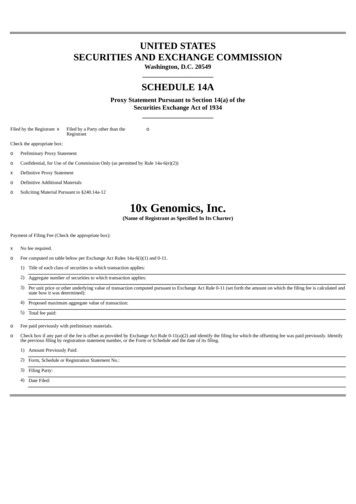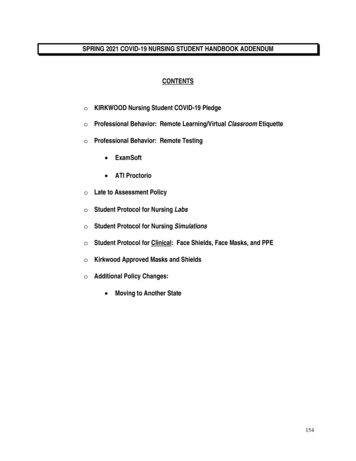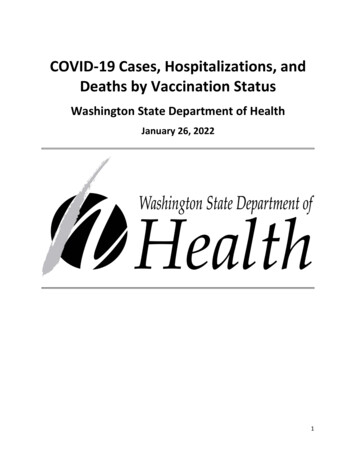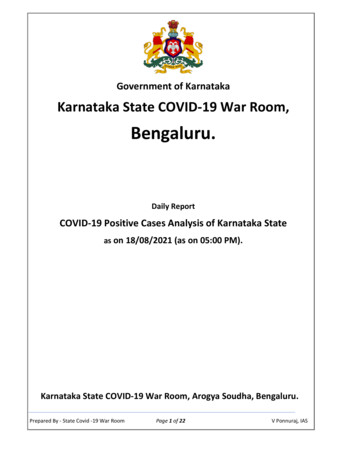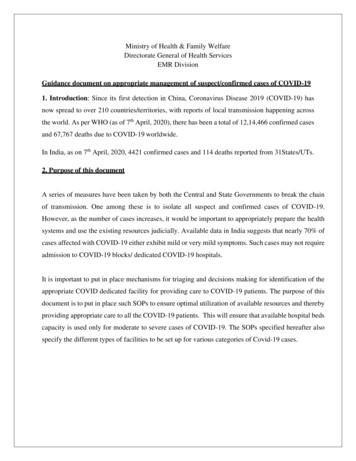
Transcription
Chapter 14a - COVID-19 - SARS-CoV-27 May 202114aCOVID-19 - SARS-CoV-2NOTIFIABLECOVID-19 disease first emerged as a presentation of severe respiratory infection in Wuhan,China in late 2019 (WHO, 2020). By January 2020, lower respiratory samples taken fromaffected patients were sequenced and demonstrated a novel coronavirus (SARS-CoV-2) (Huanget al, 2020). The first two cases in the UK were seen in late January (Lillie et al, 2020). In March2020, the WHO declared a SARS-CoV-2 pandemic (WHO Director-General, 2020).SARS-CoV-2 is a member of the family of Coronaviridae and genus Betacoronavirus (Zhuet al, 2020). Phylogenetic analysis of SARS-CoV-2 has shown that it is genetically distinctfrom the SARS coronavirus (Dhama, et al. 2020), but appears to share strong sequencesimilarity to bat coronaviruses in China (Lam et al, 2020).As with other coronaviruses, SARS-CoV-2 is an RNA virus which encodes four majorstructural proteins, spike (S), membrane (M), envelope (E) and a helical nucleocapsid (N)(Dhama et al, 2020) The S glycoprotein is considered the main antigenic target andconsists of an S1 and S2 subunit (Kaur et al 2020). The S1 subunit has two functionaldomains: the N terminal domain (NTD) and receptor binding domain (RBD) which containsthe receptor binding motif (RBM) (Kaur et al, 2020). The RBM binds to angiotensinconverting enzyme 2 (ACE2) on host cells and is endocytosed with subsequent release ofthe viral genome into the cytoplasm (Amanat et al, 2020).SARS-CoV-2 is primarily transmitted by person to person spread through respiratoryaerosols, direct human contact and fomites (Kaur et al, 2020). Estimates of the basicreproduction number [R] were initially between 2 and 3 although a recent estimate was ashigh as 5.7 (Sanche et al, 2020). This high transmissibility indicates that stringent controlmeasures, such as active surveillance, physical distancing, early quarantine and contacttracing, are needed in order to control viral spread. Perinatal transmission has beenreported although the exact transmission route has not been elucidated (ECDCa, 2020).After the initial exposure, patients typically develop symptoms within 5-6 days (incubationperiod) although about 20% of patients remain asymptomatic throughout infection (Ceviket al, 2020). Polymerase chain reaction (PCR) tests can detect viral SARS-CoV-2 RNA in theupper respiratory tract for a mean of 17 days, although transmission is maximal in the firstweek of illness. Symptomatic and pre-symptomatic transmission (1-2 days before symptomonset), is thought to play a greater role in the spread of SARS-CoV-2 than asymptomatictransmission.Chapter 14a - 1COVID-19 SARS-Cov-2The virus
Chapter 14a - COVID-19 - SARS-CoV-27 May 2021The diseaseIn adults, the clinical picture varies widely. A significant proportion of individuals are likelyto have mild symptoms and may be asymptomatic at the time of diagnosis.Progression of disease, multiple organ failure and death will occur in some individuals(Pachetti et al, 2020).Currently available data suggest that increasing age and male gender are significant riskfactors for severe infection. However, there are also groups of patients with underlyingcomorbidities, where infection may result in increased risk of serious disease (Dochertyet al, 2020). In a large review of primary care records pseudonymously linked with SARSCoV-2 status, comorbidities including diabetes, cancer and severe asthma were associatedwith increased risk of death (Williamson et al, 2020).Infection fatality ratios (IFR) for COVID-19, derived from combining mortality data withinfection rates in seroprevalence studies, show a marked increase in IFR in the oldest agegroups (Table 1) (Ward et al, 2020).Chapter 14a - 2COVID-19 SARS-Cov-2Symptoms are commonly reported as a new onset of cough and fever (Grant et al, 2020),but may include headache, loss of smell, nasal obstruction, lethargy, myalgia (achingmuscles), rhinorrhea (runny nose), taste dysfunction, sore throat, diarrhoea, vomiting andconfusion; fever may not be reported in all symptomatic individuals. Patients may also beasymptomatic (He et al, 2020).
Chapter 14a - COVID-19 - SARS-CoV-27 May 2021Table 1: Infection fatality ratio and estimated total numbers of deaths (February to July lence%(95% CI)1Confirmed Infection fatalityCOVID-19ratio %deaths2(95% CI)2Estimatednumber ofinfections(95% CI)Total56,286,9616.0 (5.7, 6.8)301800.9 (0.9, 5 (5.8, 6.6)185751.1 (1.0, 5.8 (5.4, 6.1)116000.7 (0.7, 2 (6.7,7.7)5240.0 (0.0, 6.2 (5.8, 6.6)46570.5 (0.5, 0.5)895,238(837,231;953,244)65-745,576,0663.2 (2.7, 3.7)56633.1 (2.6, 3.6)181,044(153,426;208,661)75 4,777,6503.3 (2.5, 4.1)1933011.6 (9.2, 14.1)166,077(131,059;200,646)Age (years)1 All estimates of prevalence adjusted for imperfect test sensitivity and specificity (see text for details).Responses have been re-weighted to account for differential sampling (geographic) and for variation inresponse rate (age, gender, ethnicity and deprivation) in final column to be representative of the Englandpopulation (18 ).2 Infection fatality ratios were calculated excluding care home residents. Confirmed COVID-19 death countswere obtained from ending-17-jul-2020.html. Deaths in care homes by age on 12 June 2020 were obtainedfrom www.ons.gov.uk. Total deaths in care home residents up to 17 July 2020 were obtained fromwww.ons.gov.uk. The age stratified estimates of COVID-19 deaths were then estimated using the totaldeaths from 17 July and the age distribution from 12 June. We assumed that age distribution of deathsdid not change between 12 June and 17 July 2020.Chapter 14a - 3COVID-19 SARS-Cov-2Sex
Chapter 14a - COVID-19 - SARS-CoV-27 May 2021In Europe and the UK, deaths attributed to SARS-CoV-2 have been reporteddisproportionately from residential care homes (ECDCb, 2020, Graham et al 2020). Othernotable risk groups include healthcare workers (Nguyen et al, 2020) who may acquireinfection both in the hospital or within the community setting (Bielicki et al, 2020). Currentevidence suggests that deprivation and being from black and asian minority ethnic groupsresults in a higher risk for death from SARS-CoV-2 infection (Williamson et al, 2020),although the factors that contribute to this are not yet clear.Fewer than 5% of COVID-19 cases are amongst children and in general they appear toexhibit mild disease. Although cough and fever are the main symptoms in children (Ladhaniet al, 2020), a UK study tracking children of healthcare workers has recently shown that ofthose who were seropositive, gastrointestinal symptoms were also commonplace (Waterfieldet al, 2020). Preliminary evidence suggested that not only do children have a lowersusceptibility to SARS-CoV-2 infection, but they are also unlikely to be key drivers oftransmission at a population level (Viner et al, 2020). However, a recent prospective studyfound higher secondary attack rates where the household index case was a child (LopezBernal et al, 2020).A spectrum of multi system inflammatory disease similar to Kawasaki disease (KD) wasrecently described in children admitted during the SARS-CoV-2 pandemic, temporallyassociated with severe acute respiratory syndrome attributed to SARS-CoV-2 (Paediatricmultisystem inflammatory syndrome temporally associated with SARS-CoV-2 infection(PIMS-TS)) (Whittaker et al, 2020). This severe presentation in children is extremely rare, butappears to encompass a wide range of features, including fever, gastrointestinal symptoms,rash, myocardial injury and shock (Swann et al, 2020).Pregnant women and neonatesThe risk to pregnant women and neonates following COVID-19 infection is generally low:more than half of pregnant women who test positive for SARS-CoV-2 are asymptomatic,and there is no increase in stillbirth or neonatal death rates associated with COVID-19 inpregnancy [Allotey et al, 2020]. It is still unclear whether SARS-CoV-2 can be transmittedvertically, and only about 2% of neonates born to COVID-positive mothers in the UK testpositive for SARS-CoV-2 in the first 12 hours of life (Vousden et al, 2021). However, therisk of preterm birth is increased two to threefold for women with symptomatic COVID-19(Vousden et al, 2021), usually as a result of a medical recommendation to deliver early toimprove maternal oxygenation [NICE Guideline 25, 2019 https://www.nice.org.uk/guidance/ng25]. Furthermore, a small proportion of pregnant women can have severe orfatal COVID-19. The largest global systematic review indicates that pregnant women aremore likely to be admitted to the intensive care unit (ICU) with COVID-19 than agematched non-pregnant women, (Mullins et al, 2021) and there is a signal that this is truein the UK as well ts).Pregnant women are more likely to have severe COVID-19 infection if they are overweightor obese, are of black and asian minority ethnic background, have co-morbidities such asdiabetes, hypertension and asthma, or are 35 years old or older (Vousden et al, 2021,Allotey et al, 2020).Chapter 14a - 4COVID-19 SARS-Cov-2Children
Chapter 14a - COVID-19 - SARS-CoV-27 May 2021COVID-19 vaccinesMost vaccine candidates focus on immunisation with the spike (S) protein, which is themain target for neutralising antibodies. Neutralising antibodies that block viral entry intohost cells through preventing the interaction between the spike protein Receptor BindingMotif (RBM) and the host cell Angiotensin-converting enzyme 2 (ACE2) are expected to beprotective (Addetia et al, 2020, Thompson et al, 2020).In the UK, three vaccines targeting the S protein have been authorised for supply; two usean mRNA platform (Pfizer BioNTech COVID-19 mRNA vaccine BNT162b2 and ModernamRNA-1273 COVID-19 vaccine) and the third uses an adenovirus vector (AstraZenecaCOVID-19 vaccine).The Pfizer BioNTech and Moderna COVID-19 vaccines are nucleoside-modified messengerRNA (mRNA) vaccines. mRNA vaccines use the pathogen’s genetic code as the vaccine; thisthen exploits the host cells to translate the code and then make the target spike protein. Theprotein then acts as an intracellular antigen to stimulate the immune response (Amanat et al,2020). mRNA is then normally degraded within a few days. Both the Moderna mRNA-1273and the Pfizer BioNTech COVID-19 BNT162b2 vaccines have been generated entirely in vitroand are formulated in lipid nanoparticles which are taken up by the host cells (Vogel et al,2020, Jackson et al, 2020). The Pfizer vaccine was tested in healthy adults between the agesof 18-55 and 65-85 years in phase 1 studies and the BNT162b2 vaccine product at a 30 µgdose was chosen by Pfizer as the lead candidate in phase 2/3 trials (Walsh et al, 2020). TheModerna mRNA-1273 vaccine was tested at three dose levels in those aged 18-55 years andthe 100µg dose chosen for phase 3 study (Jackson et al, 2020).AstraZeneca COVID-19 vaccine uses a replication deficient chimpanzee adenovirus (ChAd) asa vector to deliver the full-length SARS-CoV2 spike protein genetic sequence into the host cell(Van Doremalen et al, 2020). The adenovirus vector is grown in a human cell-line (HEK293)(see chapter 1). ChAd is a non-enveloped virus; the glycoprotein antigen is not present in thevector, but is only expressed once the genetic code within the vector enters the target cells.The vector genes are also modified to render the virus replication incompetent, and toenhance immunogenicity (Garafalo et al, 2020). Once the vector is in the nucleus, mRNAencoding the spike protein is produced that then enters the cytoplasm. This then leads totranslation of the target protein which acts as an intracellular antigen.Vaccine effectivenessPfizer BioNTech COVID-19 mRNA vaccine BNT162b2Two doses of Pfizer BioNTech COVID-19 mRNA vaccine BNT162b2 successfully reduced thelevels of detectable viral RNA in Rhesus macaques when followed by intra-nasal and intratracheal challenge with SARS-CoV-2 (Vogel et al, 2020). In phase 1/2 human trials, afterprime and boost vaccination, neutralising antibodies were comparable or higher than inconvalescent patients. Neutralising antibody responses were generally higher in the 18 to55 year age group compared to the 65 to 85 year age group, but responses werecomparable to levels in convalescent patients in both age groups.Chapter 14a - 5COVID-19 SARS-Cov-2The recognition of the pandemic has accelerated the development and testing of severalvaccines using platforms investigated during previous emergencies such as the SARSpandemic (Amanat et al, 2020) and Ebola in West Africa. Candidate vaccines includenucleic acid vaccines, inactivated virus vaccines, live attenuated vaccines, protein or peptidesubunit vaccines, and viral-vectored vaccines.
7 May 2021A phase 3 study was conducted in around 44,000 individuals aged 12 years and abovewith a second dose delivered between 19 and 42 days. Initial analysis conducted as part ofa phase 3 study demonstrated a two-dose vaccine efficacy of 95% (with credibilityintervals from 90.3% to 97.6%) in those aged 16 years and above. Efficacy was consistentacross age, gender, and ethnicity, and in the presence of co-morbidities (including asthma,obesity, diabetes, hypertension and lung disease). In naïve participants aged between 65and 75 years, and in those aged 75 years and over, the efficacy was 94.7% (95% CI 66.799.9%) and 100% (95% CI 13.1-100%) respectively. Efficacy remained high when theanalysis included those with evidence of prior immunity. Published efficacy between dose 1and 2 of the Pfizer vaccine was 52.4% (95% CI 29.5-68.4%). Based on the timing ofcases accrued in the phase 3 study, most vaccine failures in the period between dosesoccurred shortly after vaccination, suggesting that short term protection from dose 1 is veryhigh from day 10 after vaccination (Polack et al, 2020). Using data for those cases observedbetween day 15 and 21, efficacy against symptomatic COVID-19 after the first dose wasestimated at 89% (95% CI 52-97%). (https://www.fda.gov/media/144246/download)The Pfizer BioNTech COVID-19 mRNA vaccine BNT162b2 received approval to supply in theUK from the MHRA on 2 December 2020.AstraZeneca COVID-19 vaccineAstraZeneca COVID-19 vaccine elicited increased neutralisation antibodies in Rhesusmacaques as well as a reduction in detectable virus in the lower respiratory tract followingchallenge with SARS-CoV-2 (Van Doremalen et al, 2020). In phase 1/2 human trialsAstraZeneca COVID-19 vaccine was compared with a meningococcal conjugate vaccine(MenACWY) control in healthy adults aged between 18-55 years (Folegatti et al, 2020).Preliminary findings showed that neutralising antibodies were induced at day 14 and 28 afterthe first vaccination and titres increased after a second dose. Specific T cell responses werealso induced after a single immunisation and were maintained after the second dose. Finaldata showed that IgG spike antibody responses and neutralising antibody 28 days after thesecond dose were similar across the three age cohorts (18–55 years, 56–69 years, and 70years). More than 99% (208/209) of the participants had neutralising antibody responsestwo weeks after the second dose. Peak T-cell responses were seen 14 days after the firstdose and were broadly equivalent in the three age groups (Ramasamy et al, 2020). In analysisof over 11,000 patients in the phase 3 study, overall vaccine efficacy against symptomaticdisease was 70·4% (95% CI: 54·8–80·6%) (Voysey et al, 2020). There were ten caseshospitalised for COVID-19, of which two were severe, all in the control group, suggestingvery high protection against severe disease. High protection against hospitalisation was seenfrom 21 days after dose 1 until two weeks after the second dose, suggesting that a singledose will provide high short term protection against severe disease (Voysey et al, 2020). Anexploratory analysis of participants who had received one standard dose of the vaccinesuggested that efficacy against symptomatic COVID-19 was 73.00% (95% CI: 48.79-85.76%).The AstraZeneca COVID-19 vaccine received approval to supply in the UK from the MHRAon 30 December 2020.Moderna COVID-19 vaccineIn phase 1 testing of the Moderna mRNA-1273 vaccine, all patients seroconverted to IgGby by Enzyme-Linked Immunosorbent Assay (ELISA) after the first dose of vaccine. Pseudoneutralisation and wild virus neutralisation responses were detected in all participants afterChapter 14a - 6COVID-19 SARS-Cov-2Chapter 14a - COVID-19 - SARS-CoV-2
Chapter 14a - COVID-19 - SARS-CoV-27 May 2021two 100µg doses of the Moderna mRNA-1273. Phase 3 placebo controlled testing in over30,000 volunteers, showed a vaccine efficacy of 94.1% (95% CI: 89.3-96.8%). Efficacy wassimilar in those over 65 years. Vaccine efficacy against severe COVID-19 was 100% (95% CI:87.0-100%) (Baden et al, 2020)The cumulative case numbers in the phase 3 study showed a clear divergence between thevaccine and placebo groups from about 14 days after the first dose. Re-analysis of thephase 3 data from 15 days after the first dose to the time of the second dose, suggestedthat efficacy of a single dose was 92.1% (95% CI 68.8%-99.1%).Real world effectivenessVaccine effectiveness data from the UK is now emerging. A single dose of either the Pfizer orthe AstraZeneca vaccines has been shown to provide around 60% protection againstsymptomatic disease; vaccinated cases are also around 40% less likely to require hospitaladmission or to die (LopezBernal et al, 2021). This is consistent with protection of around80% against hospitalisation as seen in local studies (Vasileiou et al 2021, AvonCAP, 2021).Protection against infection has also been seen in healthcare workers, where a single dose ofPfizer vaccine provided more than 70% protection against both symptomatic andasymptomatic infection (Hall et al 2021), and in care home residents where a single dose ofeither Pfizer or AstraZeneca vaccines reduced the risk of infection by around 60% (Shroti et al,2021). This suggests that vaccination has potential to reduce transmission; this was supportedby a Scottish study that showed a 30% reduction in risk of infection in the householdmembers of vaccinated compared to unvaccinated healthcare workers (Shah et al, 2021).SafetyPfizer BioNTech COVID-19 mRNA vaccine BNT162b2Local reactions at the injection site are fairly common after Pfizer BioNTech COVID-19 mRNAvaccine BNT162b2, primarily pain at the injection site, usually without redness and swelling.Systemic events reported were generally mild and short lived (Walsh et al, 2020). In the finalsafety analysis of over 21,000 participants 16 years and older, the most common events wereinjection site pain ( 80%), fatigue ( 60%), and headache ( 50%). Myalgia, arthralgia andchills were also common with fever in 10-20%, mainly after the second dose. Most wereclassified as mild or moderate. Lymphadenopathy in the axillary, supraclavicular or cervicalnodes on the same side as the injection was reported in less than 1% (Polack et al, 2020).Four cases of Bell's palsy were reported in vaccine recipients in the trial. Although within theexpected background rate, this will be monitored closely post-implementation.Side effects were less common in those aged over 55 than those aged 16 to 55 years. Severesystemic effects, defined as those that interfere with daily activity, included fatigue in 4%and headache in 2%. There was no signal to suggest that prior vaccination led to enhanceddisease with only 1 case of severe COVID-19 in the 8 vaccine failures (Polack et al, 2020).Moderna COVID-19 vaccineA high proportion (more than 75%) of vaccine recipients had
Chapter 14a - 1 COVID-19 - SARS-Cov-2 Chapter 14a - COVID-19 - SARS-CoV-2 7 May 2021 14a. COVID-19 - SARS-CoV-2 . NOTIFIABLE. The virus. COVID-19 disease first emerged as

